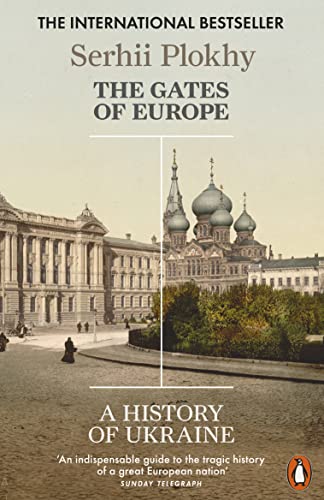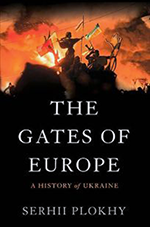One of the things I enjoy most about this blog is the annual traditions I've come to observe here. It's the end of one year and the beginning of the next? Time for a list of books I finished and a digest of those I would recommend to others! It's the first week of January? New Years' Resolutions ahoy. Summertime? #AHAReads, the summer reading challenge sponsored by the American Historical Association.
I set the following goals for my participation in #AHAReads 2023:
- read a history that's been on your shelf too long: Karen Harvey's The Impostress Rabbit Breeder
- read a history of a place you know little about: Serhii Plokhy's The Gates of Europe: A History of Ukraine
- read a graphic history: The Illustrated History of Football by David Squires
I add two elements to the challenge: writing about what I read and reading only books I own or borrow. In the first annual challenge, I managed to finish all three books between the first of June and Labor Day 2022. (Labor Day, for non-Americans, is the first Monday of September, which many people working in US universities regard as the end of summer because it usually marks the start of the new academic year.) I didn't get around to finishing my blog posts until June 2023. In the second year of the challenge, I read and blogged about only one book between June and September. Finished a second book required borrowing copies from three different libraries in two countries. (What can I say? I take my self-imposed "borrow don't buy" rule seriously.) Continuing my trend of taking a year to finish the challenge, as #AHAReads 2024 begins, here is my final post about what I read last year.
Hopefully what follows will inspire you to consider reading the Gates of Europe for yourself.
 |
| #AHA Reads: 2023 Summer Reading Challenge Bingo Card |
"Whatever the outcome of the current Ukraine Crisis, on its resolution depends not only the future of Ukraine but also that of relations between Europe's east and west--Russia and the European Union--and thus the future of Europe as a whole." (p. 354)This theme of interconnection is also apparent in Plokhy's account of Ukraine's relationship with its neighbours. I was particularly struck by the richness and complexity of connections between Ukraine and Poland, briefly captured in a wonderful discussion of the relationship between the two countries' national anthems.
"The Ukrainian national anthem begins with the words "Ukraine has not yet perished", hardly an optimistic beginning for any kind of song. But this is not the only anthem whose words do not inspire optimism. The Polish national anthem starts with the familiar line "Poland has not yet perished." The words of the Polish anthem were written in 1797 and those of the Ukrainian one penned in 1862, so it is quite clear who influenced whom. But why such pessimism? In both cases, the idea of the death of the nation stemmed from the experience of the late eighteenth century--the partitions of Poland and the liquidation of the Hetmanate." (p. 147)
 |
| The Gates of Europe: A History of Ukraine by Serhii Plokhy, Penguin Cover |
"The idea of liberty and the protection of individual rights took centre stage in the writings of the period, but so too did notions of rational governance and monarchical absolution. The modern republic and the modern monarchy both have deep roots in the ideas of the French philosophers. Both the founding fathers of the United States and the absolute rulers of eighteenth-century Europe were disciples of the Enlightenment." (p. 134)
"The Catholic rebels wanted a Catholic state without Russian interference, while the Orthodox wanted a Cossack state under the jurisdiction of Russia. The Jews wanted to be left alone. None of the groups got what it wanted." (p. 139)
"In January 1872, his newly built ironworks produced its first pig iron. In the course of the 1870s, he added more blast furnaces. The works employed close to 1,800 people, becoming the largest metal producer in the empire. The places were the workers lived became known as Yuzivka after the founder's surname ("Hughesivka"). The steel and mining town would be renamed Staline in 1924 and Donetsk in 1961." (p. 180)
One of the pleasures of reading this book is how smoothly Plokhy follows chains of causation. It would be easy for the events of the twentieth century to dominate the book, but these events are always traced back to their earlier roots. For instance, the political divisions of early-twentieth century Ukraine are connected to their roots in the cultural revival of the 1830s and 1840s (p. 193). The foundation of Ukraine's national library, archive, academy of sciences, universities, and even the use of Ukrainian as a national language, are presented not just as a response to events such as the Russian Revolution, but as part of a much longer arc of historical change (p. 211).
The heart of the book is twentieth-century history: the immense and devastating consequences of collectivization and Ukrainian uprisings in response (p. 249); the beginning of the Holodomor in 1932, and Stalin’s complete denial it was happening (p. 251-3); and the devastating impact of the German occupation of Ukraine during the Second World War (p. 260). Fun medievalist fact: the German invasion of the Soviet Union was named after a twelfth-century Holy Roman Emperor, Frederick Barbarossa. As Plokhy points out, that was certainly a choice.
"[Barbarossa] had drowned while trying to cross a river in heavy armor instead of taking the bridge used by his troops. It was certainly a bad omen, but at the time those in the know paid no attention to historical precedent." (p. 263)
One thing I hadn't known or appreciated before reading this book is the
depth and complexity of Ukrainian Jewish history. From the rich history of
Ukraine's early modern Jewish communities to the twentieth century
history's history of revolutions, this was yet another subject that could be a book of its own. As often happens to me when getting to
grips with a totally unfamiliar history, what sticks in my memory is not
the broad outlines of historical development, but anecdotes, such as a
haunting story about the recapture of Kyiv from the Germans during the
Second World War. A Jewish man, who had been hidden by his Ukrainian
wife, ran screaming towards Nikita
Kruschchev, shouting about being the only Jew left in the city. (p. 277)
The book's first (and only) reference to Ukrainian Muslims also occurs in the
context of WWII history (p. 268).
The shadow of the second world war in twentieth-century Ukrainian history could itself be yet another book. Plokhy comments:
"As in the camps, the line between resistance and collaboration, victimhood and criminal complicity in the regime became blurred but by no means indistinguishable. Everyone made a personal choice, and those who survived had to live with their decisions after the war, many in harmony, some in unending anguish. But almost everyone suffered survivor’s guilt." (p. 269)
Until the 1980s, Soviet
citizens were required to disclose if they or their relatives had
lived under German occupation (p. 275). The complex legacies of the Second World War also explain controversies over the reception of figures like Stepan Bandera (p. 335).
The sections of the book that cover Soviet and post-Soviet history are the ones for which I have the fewest notes, possibly a reflection of the points at which I had to put the book down for extended periods. One thing I did notice is the relative lack of references to women. The revolutionary teacher and leader
Agafya "Halyna" Andriivna Kuzmenko is covered in a half sentence: "the
Ukrainian national agenda was not entirely foreign to Makhno—his
teacher wife promoted it" (p. 225). Women feature as significant figures in discussion wider
historical developments (see for example pp. 284-5), but often feel surprisingly absent from the wider narrative, which seems a missed opportunity to further strength the book's thesis of complexity and interconnection.
 | |
| The Gates of Europe: A History of Ukraine by Serhii Plokhy, Basic Books Cover |
The Russo-Ukrainian conflict, while arising unexpectedly and taking many of those involved by surprise, has deep historical roots and its replete with historical references and allusions. Leaving aside the propagandistic use of historical arguments, at least three parallel processes rooted in the past are now going on in Ukraine: Russia's attempts to reestablish political, economic, and military control in the former imperial space acquired by Moscow since the mid-seventeenth century; the formation of modern national identities, which concerns both Russians and Ukrainians (the latter often divided along regional lines); and the struggle over historical and cultural fault lines that allow participants in the conflict to imagine it as a contest between East and West, Europe and the Russian World. (p. 348)In 2014, Plokhy concluded his book with measured optimism. "Ukraine faces the enormously difficult task of reforming its economic, political, and legal systems while defending its integrity and sovereignty, but there is growing hope that it can succeed. That hope is based above all on the ingenuity and determination of the Ukrainian people." (p. 345). Reading the book in 2023, and writing about it in 2024, I cannot help but hope he is right.
Further Reading
- Інна Березніцька, Іра Шепетко, translated by Hanna Leliv. (2023). "I wanted to become a good historian." The Ukrainians. https://theukrainians.org/i-wanted-to-become-a-good-historian/
- Martha Bohachevsky-Chomiak's Feminists Despite Themselves: Women in Ukrainian Community Life, 1894-1838 (1988).
- Charlotte Higgins (2023). "Ukrainian historian Serhii Plokhy: ‘This may not be the last chapter of the Russian empire, but it’s an important one'". The Guardian. https://www.theguardian.com/books/2023/may/12/historian-serhii-plokhy-the-russo-ukrainian-war
- House of Commons Library, Conflict in Urkraine: A Timeline (2014-eve of the 2022 invasion), https://commonslibrary.parliament.uk/research-briefings/cbp-9476/
- Internet Encyclopedia of Ukraine
- Serhii Plokhy, (2023). The Russo-Ukrainian War: the Return of History. London: Penguin Books.
- Serhii Plokhy, (2023). "Serhii Plokhy's Diary: the trains are still running in Ukraine." Prospect Magazine. Available from: https://www.prospectmagazine.co.uk/views/63720/serhii-plokhys-diary-the-trains-are-still-running-in-ukraine
- Ivan Velychkovsky, Lazar Baranovych, and Simeon Polotsky, all late 17th century writers
- Ivan Kotliarevsky's, Eneïda (1798), a re-imagining of the Aeneid with Cossack characters, regarded as the first major poem in the Ukrainian vernacular
- Mykola Tsettelev, who published the first collection of Ukrainian folk songs
- Oleksii Pavlosky, who wrote the first grammar of the Ukrainian language
- Mykhailo Hrushevsky, a significant Ukrainian historian
- Taras Shevcenko, an important writer and poet, whose life is worth of a historical novel
- Afanasy Matushenko, a revolutionary socialist who led the Potemkin mutiny and another figure whose life could be a novel
- Olha Kobylianska, a modernist writer and feminist
- Anne of Kiev, whose letter to her father complaining about the barbarous lack of civilization in eleventh century France makes me want to find a good historical novel about her
- Roxolana, the consort and wife of the Ottoman Sultan Suleiman the Magnificent
A note on spelling: Plokhy's name is spelled differently on his Harvard faculty page and on the covers of his books.
Both spellings seem to be used in recent articles and spellings so I have used Plokhy here.
No comments:
Post a Comment